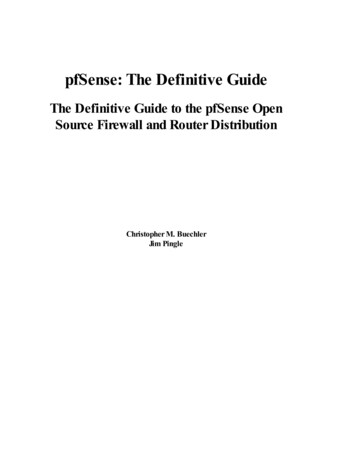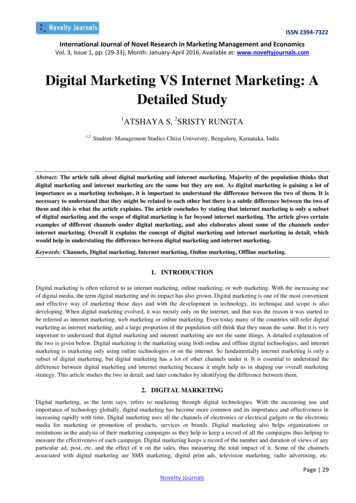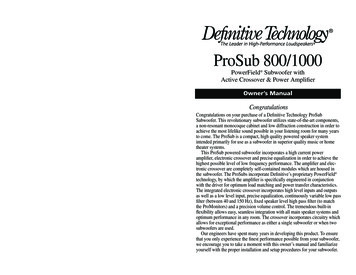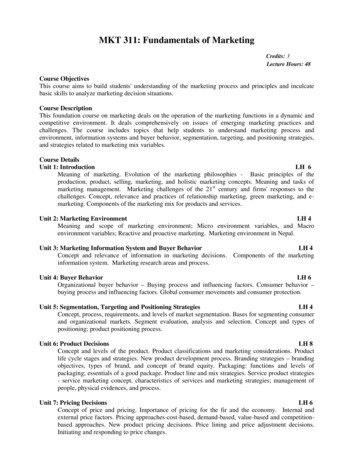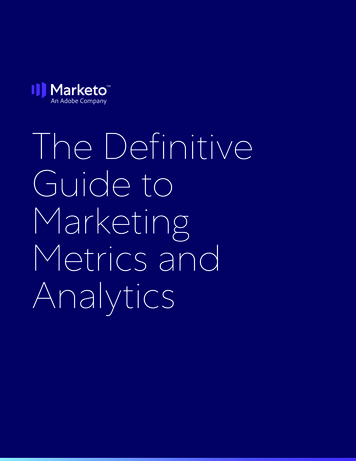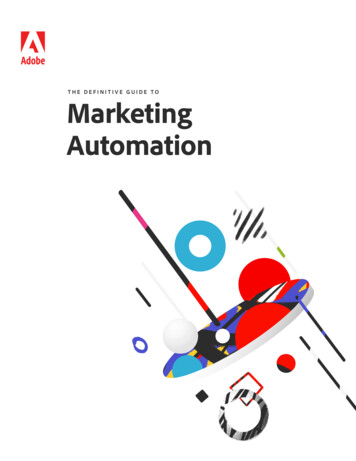
Transcription
THE DEFINITIVE GUIDE TOMarketingAutomation
Table of contentsIntroduction: Putting your marketing on automatic3Understanding the marketing automation basics4Comparing marketing automation to other solutions12Getting to know marketing automation features21Making a winning business case for marketingautomation31Ensuring your success with marketing automation45Investing in the right marketing automation platform51Envisioning the future of marketing automation59Discovering Adobe Marketo Engage67Conclusion: Propelling your marketing692
Introduction: Putting yourmarketing on automaticDiscovering the magic of marketing automationMeet your business’s new best friendWelcome to the Definitive Guide to Marketing Automation. In this guide, we’ll show youthe ropes of marketing automation and explain how putting your marketing on automaticcan transform your company. You’ll also learn how to select the right system for yourorganization and get a sense of the investments necessary for success.Every business aims to achieve higher revenue and faster growth. But many companiesstruggle to combine their people, processes, and technology to actually attain thesegoals. Marketing automation software lets companies streamline, automate, and measuremarketing tasks and workflows so you can increase operating efficiency and growrevenue faster. But getting started with marketing automation is a big step that requiresresearch, reliable information, and good recommendations.In this guide, you’ll learn the following: Find out why marketing automation has grown so quickly Discover how marketing automation differs from other solutions, such as customerrelationship management (CRM) and email marketing Get to know common features and advanced functions of marketing automation tools Build a business case around marketing automation and convince others in yourorganization to act Select the best marketing automation for your particular organization Know what to expect for the future of marketing automationIn addition to our thorough overview of marking automation, we’ve also includedworksheets to help you determine whether it’s right for you—and if it is, howmarketing automation can help you earn ROI and reach other business goals.We hope this guide will open up opportunities for more effective, efficient, andexciting marketing.3
Understanding the marketingautomation basicsThe shift from manual to automatic marketingIf you’re chasing leads only to find they aren’t qualified or struggling to track engagement acrossthe customer lifecycle, it’s likely you’re still using manual marketing methods. Not only can thisbe frustrating, but it can impact the success of your programs and the revenue your companyearns. Only by nurturing leads likely to buy and engaging with them throughout the customerjourney will you know which activities produce results and how much revenue they cancontribute. That’s where marketing automation comes in.You may wonder what marketing automation can handle that you can’t manage manually.Take a look at just a few of the marketing tasks it can make easier—or transform fromimpossible to possible: Send tailored marketing emails to target audiences Easily create new landing pages for each campaign Set up all emails for an event before it starts and run them automatically, withno interference Rank a list of potential customers on the likelihood they’ll buy Filter leads by level of engagement and interest in your brand Measure the revenue contribution of each of your marketing programsMarketing automation can help you scale programs, deliver more personal and targetedcommunications, partner with sales, and measure results—and that’s just scratching the surface.As you read through this guide, you’ll learn about the many ways marketing automation canhelp your organization transform the way you connect to your audience.4
Marketing automation definedMarketing automation software streamlines, automates, and measures the resultsof marketing tasks and workflows. It enables many modern marketing practices,including the following: Lead generation Segmentation Lead nurturing and lead scoring Relationship marketing Cross-sell and up-sell Retention Marketing ROI measurementThe result: You operate more efficiently and grow revenue faster. If your company has a smallnumber of prospects and customers, you can carry out some of the practices above withoutmarketing automation. But to scale up, technology is essential.Marketing automation can help small-to-mid-sized businesses as well as enterprises. Largecompanies have long found value in marketing automation, but it’s important to note thatmarketing automation isn’t just for enterprises. In fact, small and mid- sized businesses(SMBs)—those with annual revenue between 5 million and 500 million—make up thefastest growing segment in the marketing automation space right now. Thousands of evensmaller companies use marketing automation as well.Industries of all kinds use marketing automation, whether they’re B2B, B2C, or a hybrid of both.Early adopters were primarily in B2B industries such as high-tech and software, manufacturing,and business services. But increasingly, companies across all categories—including B2Cindustries like healthcare, financial services, media and entertainment, and retail—are adoptingmarketing automation for its real-time, customer-centric approach to maintaining and extendingrelationships with audiences.5
A feature for every needMarketing automation platforms manage a variety of features and functions, includingemail marketing, landing pages and forms, campaign management, lead nurturingand scoring, lead lifecycle management, customer relationship management (CRM)integration, social media marketing, and marketing analytics.Skip ahead to Part 4: Getting to know marketing automation features forin-depth information.Marketing automation entMarketingProgramsLeadGenerationPrediction& esourceManagmentMarketingAnalytics6
What marketing automation isn’tBefore we talk more about how marketing automation can help you, let’s clear upsome common misconceptions. Marketing automation is not any of the following:1. A fancy name for email marketing. Marketing automation is so much more thanemail. As the term suggests, marketing automation handles campaigns across allchannels—from direct mail and phone to online and social. In addition, marketingautomation combines robust capabilities from your CRM, lead management system,web analytics platform, and other systems to create a whole that’s greater than thesum of the parts. The insight you gain can set you up for increased ROI.2. A way to send spam. Definitely not. Marketing automation delivers results basedon how you use it. Yes, it can be used for marketing practices that ignore thecustomer experience, like spam. But it can also be used for exceptional marketingthat truly connects with customers.3. A solution that only benefits your marketing department. Yes, your marketingdepartment will benefit from marketing automation. But high-quality marketingautomation is ultimately about growing revenue quickly and efficiently—and thatbenefits every part of your company.4. A solution that delivers value without effort. Unfortunately not. Marketingautomation is not magic, although it might seem like it at times. To deliver tangibleresults, it requires the support of a broad strategy that integrates the right processes,people, content, and data. Don’t take success for granted. To find out what you needto succeed, check out Part 6: Ensuring your success with marketing automation.7
How marketing automationcan helpIn addition to its timesaving and efficiency benefits,marketing automation supports business processesessential to any modern marketing department. ForB2B companies, these processes include lead nurturing,lead scoring, and lead lifecycle management. For B2Ccompanies, they include cross-sell, up-sell, and retention.And for all companies, essential processes includemarketing ROI analytics.Marketing automation nurturesrelationships with leads whoaren’t ready to buy.On average, only 20 percent of leads are sales-ready whenthey first come in. This means you need a disciplinedprocess—known as lead nurturing—to develop qualifiedleads until they are sales-ready. When done well, nurturingcan lead to increased sales and a lower cost per lead.To learn about this critical process, download The DefinitiveGuide to Lead Nurturing.Marketing automation helpsmarketers retain and extendcustomer relationships.Your job is far from finished once someone becomes acustomer. For most industries, the real value comes whenyou maintain and deepen the customer relationship overtime. This includes selling more of the same product tothe customer (up-sell), selling additional products to thecustomer (cross-sell), and driving customer loyalty andretention. Note that relationship marketing means morethan sending a monthly newsletter. You need multipletracks for each customer persona and buying stagethat correspond to the customer’s actions and adjustaccordingly—as you would in any relationship.Without marketing automation, youare just guessing—just hoping thatpeople will take the bait and be readyto buy your products. Statistics showthat buyers don’t do that. They want tolearn at their own pace and be reachedwhen they need more information orare ready to buy. A well-constructedmarketing automation strategy makesthat a reality.Ann HandleyChief Content Officer, MarketingProfsMarketing automation buildsyour partnership with sales.Many of the so-called “leads” you generate are not trueprospects for your products. You need demographic leadscoring to find the customers who fit your target profile. Moreimportantly, you need behavioral lead scoring to find thosewhose buying behaviors show that they are ready to engagewith your company and make a purchase. Once you’veidentified a lead as “hot,” you want to make sure the salesteam follows up quickly—and in a relevant way. You need tointegrate with your CRM and automatically alert sales, recycleleads, and establish service level agreements (SLA).To learn more, download The Definitive Guide to Lead Scoring.8
Marketing automation proves—and improves—marketing ROI.Executives need more than automation to prove which marketing programs are (oraren’t) working. With marketing automation, CMOs get the metrics they need to speakconfidently to other executives about the marketing department’s revenue impact.Marketing automation enables marketers to adopt an integratedapproach to generating, nurturing, and converting leads intocustomers by automating various marketing techniques andprocesses to optimize the marketing-sales pipeline. It is rapidlybecoming a standard practice, with an increasing number oforganizations turning to marketing automation to solve problems,such as diminishing lead quality, proving contribution to the salespipeline, and difficulty evaluating a lead’s readiness for sale.EconsultancyMarketing Automation Buyer’s Guide9
Find out if you’re ready to start withmarketing automationIf you aren’t sure whether your company is ready to start with marketingautomation, there are three easy steps you can take to find out.Step 1: Write down your goalsStep 2: Determine your needsMobile-optimizedOffers A/B testingLead nurturingStep 3: Compare your optionsOption 1Option 2Option 3For in-depth guidance on whether marketing automation is right for you, followthe instructions on this worksheet.10
Case study: AlgonquinCollege HighlightsHighlights Improved lead generation by 28 percent year overyear and increased sales by 18 percent Lowered cost of distribution and marketing Enabled precise measurements to determinewhich campaigns were most valuable for closingnew business Provided an understanding of what was requiredto move prospective students from considerationto buying Allowed marketing to measure ROI and take aleadership role in driving higher revenuesChallengesWith campuses in Ottawa, Canada’s capital, and acrossthe Ottawa Valley, Algonquin College has over 19,000full-time students and more than 36,000 continuingeducation students.To generate student leads, the organization used batchemails, leaving the college unable to track the effectivenessof its marketing content. In addition, due to the diversestudent base, the sales cycle could range from just a fewdays to several years. The college needed a marketingsolution flexible enough to provide detailed insight intoprospect behavior and the sales pipeline.SolutionAlgonquin College considered several marketingautomation products before ultimately selecting MarketoEngage based on its ease of use and Salesforce integration,which were at the top of their requirement list. However,the marketing staff were also pleased that Marketo Engagecould provide first-hand insight into how customersprogressed through a website, interacted with landingpages, and responded to marketing campaigns in real time.Their marketing organization is now in a position to movefrom basic nurturing to “advanced nurturing”—using a setof elaborate campaigns and triggers to launch relevant,targeted content at the instant the prospect expressesinterest. This capability allows Algonquin to further refinehow they segment leads and ensure they always deliver theright message at the right time.BenefitsWith marketing automation, Algonquin College has gaineddeep, actionable insight to determine the content that hasthe most immediate positive impact on lead generation,open rates, conversion rates, and closed sales.As a result, the marketing department improved workflowsand moved prospects through the buying cycle faster. Theyhave improved lead generation by 28 percent year over yearand increased sales by 18 percent, all while lowering theircost of distribution and marketing. In addition, the abilityto measure ROI has dramatically improved with MarketoEngage, letting the marketing team take a leadership role indriving higher revenue.Why market across the entire lifecycle?28%increase in lead generationyear over year.18%increase in sales yearover year.11
Comparing marketing automationto other solutionsA stand-alone solution that plays well with othersYou probably want to know what sets marketing automation apart from solutionsyou’ve already purchased or used—and whether you need more technology to make itwork. In this section, we’ll walk you through exactly what marketing automation adds toyour toolbox and how you can integrate it into your technology stack.Marketing automation and its relationship to CRMMany customer relationship management (CRM) systems already have a module formarketing. If this is your case, you might wonder whether you really need marketingautomation. But if you dig into the design and capabilities, you’ll find that althoughCRM systems provide value to sales organizations, they fall short for most marketingdepartments. CRM systems serve a very different purpose, which is what creates anopening for marketing automation solutions.From a functional perspective, CRM systems typically don’t let you send emails,track prospect behavior, or manage marketing programs. Many CRM systems can becustomized to handle tasks like automated campaign flows, lead scoring, andde-duplication. But even that can be a challenge.Marketing automation helps marketing departments in ways that CRM systems simplycan’t—and CRM systems help sales and other departments in ways marketing automationcan’t. Both systems are necessary to businesses. Today, CRM systems and marketingautomation can work together seamlessly.Business goalDepartment focusCommunicationstyleArchitectureCRMMarketing automationTrack opportunities and pipeline,manage contact and accountinformationDevelop customer relationships,automate marketing programs,measure marketing ROIPrimarily sales and salesmanagement, some marketingPrimarily marketing and marketingmanagement, some salesIndividual communication(sales rep to prospect)Communications to groups andsegments (but may be personalizedand triggered 1:1)Database-oriented,transactional queriesWorkflow-oriented, highly detailedbehavioral data queries12
When it comes to marketing automation capabilities, using CRM islike building a car from a kit. All the parts are there, but you need thetime and skill to put it all together. Using marketing automation islike buying the car you want or need, with all the features you wantalready installed and some gas in the tank, ready to drive. In eithercase, you still need to know how to drive and where you want to go.Mac McintoshPresident, AcquireB2BMarketing automation and its relationship toemail marketingAs a marketing tactic, email still has a tremendous impact. But the world is changing.With the deluge of messages customers receive every day, emails have to be morerelevant and engaging than ever for a customer to take the time to read them.Despite the prevalence of email marketing, not all companies are succeeding with it.Marketers struggle with targeting, formatting, and delivery timing. It’s no surprise thatengagement—the primary metric for email response rates—is falling along with openand clickthrough rates.Other common marketing tools—such as CRM, landing pages, social media, andweb analytics—only compound the problem. When tools like these don’t integratewith email marketing solutions, it puts email in a silo. Plus, email creates endlessadministrative work for marketing teams that try to connect processes and consolidatereporting manually. Costs quickly escalate for one-off email solutions that deliver poorROI. And revenue flounders because companies fail to segment their audiences, whichleads to inconsistent, impersonal customer experiences.The answer is to use email solutions that coordinate with other tools, start dialoguesthat build relationships, and engage customers—not an entire company—on theirschedules. That’s where marketing automation comes in.13
A marketing automation solution delivers essentially all the benefitsof an email marketing solution along with integrated capabilitiesthat would otherwise need to be cobbled together using variousstandalone technologies.Gleanster ResearchSeven signs you need to graduate from emailmarketing to marketing automationHow to tell if your company is ready to move up to a more mature solution.1. You’re sending email blasts rather than engaging in customer dialogue.2. You’re losing valuable time with manual email campaigns.3. Your email marketing exists in a silo.4. You can’t segment or target key audiences.5. You’ve got “trigger insensitivity” issues.6. You can’t tell if your email is driving pipeline or revenue.7. Your sales team is frustrated.14
Seven signs you need to graduatefrom email marketing1. You’re sending email blasts rather than engagingin customer dialogue. Generic marketing pitches andemail blasts won’t capture your audience’s attention.Customers are willing to engage with relevant contentand build relationships with companies they like—aslong as you approach them in the right way. To engagein a relevant dialogue, you need to nurture yourrelationships with customers patiently, over time, andmove them patiently through their purchase journey.The first step in making your email blasts engagingis to map out adaptable workflows. In other words,you should adjust your email campaigns based onthe responses and behaviors of your prospects. This iswhere marketing automation comes in. Without it, youare limited to batch-and-blast email campaigns that arebased on your timetable, not your prospects’ needs andactions. You’re decreasing your chance to get relevantcontent to your customers when they want it.2. You’re losing valuable time with manual emailcampaigns. Many companies struggle to nurturecustomer relationships. These companies might see theopen rate for an email campaign, but have no way totake the next step or respond to these metrics efficiently.As a result, they end up manually analyzing data,creating lists, and setting calendar notices to simulate apersonalized marketing experience for each customer.Tasks done by hand limit their ability to scale theirefforts. Instead of being able to clone and individuallytweak similar campaigns, they lose time by buildingevery new campaign from scratch.3. Your email marketing exists in a silo. Customers noticewhen your emails aren’t integrated with interactions onother channels. This could look like a customer receivingan email offer for a product they’ve already purchased,or a customer getting different, unrelated messagesover email, social media, and your website—all on thesame day. Marketing automation can help streamlineyour customer communications not just over email, butacross every channel. The goal is to provide consistent,compelling experiences everywhere your customer is.4. You can’t segment or target key audiences. Much ofyour marketing campaign’s success depends on yourability to segment your database and target specificleads and contacts. The more meticulously you targetand the more relevant your message, the better yourresponse rates and your ROI.Good targeting today means using both demographicand firmographic filters—in other words, who the personis and, if needed, what company the person worksfor. Key metrics also include behavioral filter—whichwebsites customers visit, which keywords they use, andwhat they say on social networks. If your email channelexists in a silo, you’ll won’t be able to use customerbehavior to target the right people in the right way at theright time.You also need to know where your prospect is in thebuying cycle—whether they are an early-stage prospect,an active lead, or an engaged customer. Without a wayto segment your customers by their stage in the buyingcycle, it’s nearly impossible to send them a timely,relevant message—especially at scale.5. You have “trigger insensitivity” issues. Triggers arecustomer behaviors that you should notice and answerwith a tailored response. Real-time triggers includethe following: A customer visits a web page A customer fills out a form A customer’s lead score changes An opportunity updates in the CRM system An activity gets loggedAny of these actions should trigger a response, which oftenmeans a relevant and real-time customer email. Timelinesscan make the difference between interest and indifference.For example, according to InsideSales, there is a 900 percentincrease in contact rate when a sales rep calls a lead withinfive minutes versus ten minutes.15
6. You can’t tell if your email is driving pipeline or revenue. You can get reportsfrom email platforms about open rates and clickthrough rates, but what youreally need to know is which activities are leading to actual revenue. Without thisconnection, you can’t determine or improve you marketing ROI.7. Your sales team is frustrated. If your sales team doesn’t know which leads arequalified and need follow-up, or if they can’t send their own marketing emails, you’reup against a big challenge. When marketing and sales don’t work closely togetherand agree on the way to qualify leads, sales becomes frustrated and sees less value inmarketing. Sales and marketing need to work closely together for success.Marketing automation is breaking free of email.Eric WittlakeResearch Analyst and Advisor, Marketing and Account Basedfor Leading B2B CompaniesI can explain a move from an email service provider (ESP) to amarketing automation platform with an analogy—still photographsversus video. ESPs are like still photographs—you can get great statsfrom using one, but each campaign is effectively a snapshot in time.Marketing automation platforms are like video—you can see thebehavior of people in multiple campaigns over time, taking all thesnapshots and connecting them together to make a ’flip movie’ orvideo out of them.Joseph ZuccaroFounder and President, Allinio LLC16
Marketing automation and its relationship toinbound marketingInbound marketing helps potential customers find your company—often before theyare even considering a purchase—and turns early awareness into brand preference.This can produce leads and ultimately result in revenue. An inbound marketer’s job isnot to find leads, but to help leads find them. To do that, they create compelling contentto attract attention and build their audiences.How marketing automation makes inbound marketing more effectiveDue to the limitations of inbound marketing—like difficulties targeting a specificaudience and pushing customers towards action—a complete marketing strategyneeds to include a range of approaches, including events, webinars, email, andadvertising—plus inbound tactics.To extract the most value from inbound marketing, companies need to combine itwith relationship marketing, lead scoring, and other aspects of marketing automation.We call this the “inbound marketing multiplier.” Without it, inbound marketing simplygenerates the names of raw prospects for your business but doesn’t turn them intoleads and customers.Inbound marketing is a strategy, not a technology. Many technology solutions can helpwith inbound marketing, including blogging software, content management systems,search engine optimization (SEO), and social media monitoring. These can also workwith a marketing automation solution. Inbound marketing solutions work better whencombined with marketing automation technology, so consider implementing both.The best marketers are using both inbound marketing and marketingautomation together, and they are getting great returns.Greg HeadFormer CMO of InfusionSoft17
Common inbound marketing misconceptions aboutmarketing automationSome inbound marketing vendors still believe that marketing automation meansrobotic communications or spam. The truth is that marketing automation is what youmake of it—and when used well, it can be a major asset for your company. Especiallywhen it’s paired with the right inbound marketing solutions.Use the following table as a guide for speaking with vendors about marketing automation.Marketing automationmisconceptions:ResponseIt doesn’t build the list.Marketing automation gives you many ways to generate leads.Complete solutions can generate leads from online and offlineevents, pay-per-click ads, and web personalization, as well asorganic programs such as social and content marketing.It’s too narrow and toofocused on email.Marketing automation gives you a holistic view of your customerthat extends across channels. Today’s solutions combineinformation from your CRM, social media, website, purchasehistory, and more so you can trigger relevant interactions at theright time over any channel.It’s not social.It ignores current customers.Marketing automation systems today integrate seamlesslywith social media. This includes profiles, campaigns, sign-on,and promotions. You can trigger marketing actions based oninteractions, such as posting or sharing content.Marketing automation helps build customer advocacy. You canuse the same segmentaion and nurturing capabilities needed towin new business for developing and deepening relationships withcurrent customers, not just prospects.18
Marketing automation and itsrelationship to social media andcontent marketingSocial media and content marketing have become keyparts of the marketing mix. Although they are bothessential tactics for building awareness and generatingleads, they still require marketing automation to convertthose leads into revenue. Without marketing automation,you can’t measure the effectiveness of these programs.Social media marketing is the process of buildingrelationships online on social media platforms andinfluencing customers even before they’re identified aspotential leads.During the early days of social media marketing, everyonetalked about the importance of social listening and havinga presence on sites like Facebook, Twitter, and LinkedIn.Today, marketers recognize that social is more than justa channel or tactic. It’s a strategy that should be presentin every aspect of your marketing. Going social withevery campaign and developing your audience into brandambassadors can be a huge plus for your organization.Content marketing is the process of creating anddistributing valuable content to attract, engage, andacquire prospects to drive conversions.Content strategies operate on the belief that customerswill ultimately reward companies who deliver consistent,relevant information with their business and loyalty. TheROI of your content marketing hinges on your ability tocommunicate with prospects and customers withoutpitching products or services. Then, they’ll look forward tohearing from your brand. Customers may also engage withyour content and amplify your message by sharing it withtheir networks.The need for automation in socialmedia and content marketingLike inbound marketing, social media and contentmarketing are ways to respond to changing customerbehavior in an era of information overload. All threestrategies deliver results and should be part of yourmarketing portfolio.Note, however, that these three tactics are top-of-funnelstrategies. They build awareness and can generate newnames for your database. But most of these leads will notbe ready to make a purchase—particularly because goodcontent, inbound, and social media marketing tends toentertain and inform broadly, rather than promote and sellspecific products and services. Although highly effective,these three tactics are unlikely to deliver revenue ontheir own.Marketers are beginning to realizethat the quality of content is crucial tosuccess in both lead generation andlead nurturing. Marketing automationwill yield higher conversion rates andROI because campaigns are bettertargeted towards the right personaand utilize consistently high quality,relevant content.John MctigueFormer Executive Vice P
student base, the sales cycle could range from just a few days to several years. The college needed a marketing solution flexible enough to provide detailed insight into prospect behavior and the sales pipeline. Solution Algonquin College considered several marketing automation products before ultimately selecting Marketo


